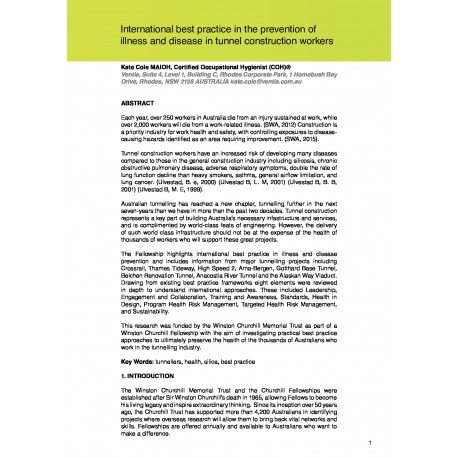Cart
0
0
No document
0,00 €
Total
Document successfully added to your shopping cart
Quantity
Total
There are 0 items in your cart.
There is 1 item in your cart.
Total documents
Total shipping
To be determined
Total
Search & filter
Search for a publication
Search & filter
International best practice in the prevention of illness and disease in tunnel construction workers
1202_international_best_practice
Each year, over 250 workers in Australia die from an injury sustained at work, while over 2,000 workers will die from a work-related illness. (SWA, 2012) Construction is a priority industry for work health and safety, with controlling exposures to diseasecausing hazards identified as an area requiring improvement. (SWA, 2015).Tunnel construction workers have an increased risk of developing many diseases compared to those in the general construction industry including silicosis, chronic obstructive pulmonary disease, adverse respiratory symptoms, double the rate of lung function decline than heavy smokers, asthma, general airflow limitation, and lung cancer. (Ulvestad, B. e, 2000) (Ulvestad B, L. M, 2001) (Ulvestad B, B. B, 2001) (Ulvestad B, M. E, 1999).Australian tunnelling has reached a new chapter, tunnelling further in the next seven-years than we have in more than the past two decades. Tunnel construction represents a key part of building Australia’s necessary infastructure and services, and is complimented by world-class feats of engineering. However, the delivery of such world class infrastructure should not be at the expense of the health of thousands of workers who will support these great projects. The Fellowship highlights international best practice in illness and disease prevention and includes information from major tunnelling projects including Crossrail, Thames Tideway, High Speed 2, Arna-Bergen, Gotthard Base Tunnel, Belchen Renovation Tunnel, Anacostia River Tunnel and the Alaskan Way Viaduct.Drawing from existing best practice frameworks eight elements were reviewed in depth to understand international approaches.




